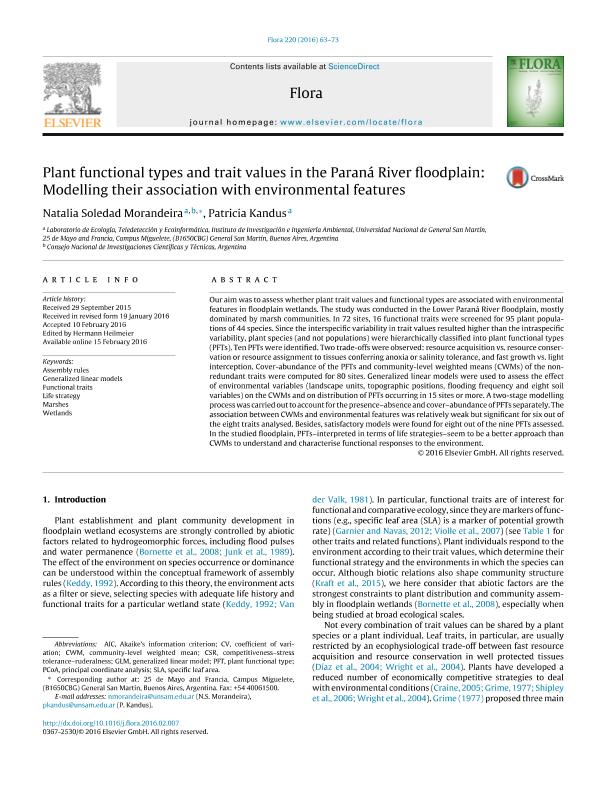Mostrar el registro sencillo del ítem
dc.contributor.author
Morandeira, Natalia Soledad

dc.contributor.author
Kandus, Patricia

dc.date.available
2018-04-27T19:38:27Z
dc.date.issued
2016-02
dc.identifier.citation
Morandeira, Natalia Soledad; Kandus, Patricia; Plant functional types and trait values in the Paraná River floodplain: modelling their association with environmental features; Elsevier Gmbh; Flora; 220; 2-2016; 63-73
dc.identifier.issn
0367-2530
dc.identifier.uri
http://hdl.handle.net/11336/43732
dc.description.abstract
Our aim was to assess whether plant trait values and functional types are associated with environmental features in floodplain wetlands. The study was conducted in the Lower Paraná River floodplain, mostly dominated by marsh communities. In 72 sites, 16 functional traits were screened for 95 plant populations of 44 species. Since the interspecific variability in trait values resulted higher than the intraspecific variability, plant species (and not populations) were hierarchically classified into plant functional types (PFTs). Ten PFTs were identified. Two trade-offs were observed: resource acquisition vs. resource conservation or resource assignment to tissues conferringanoxia or salinity tolerance, and fast growth vs. light interception. Cover-abundance of the PFTs and community-level weighted means (CWMs) of the non-redundant traits were computed for 80 sites. Generalized linear models were used to assess the effect of environmental variables (landscape units,topographic positions, flooding frequency and eight soil variables) on the CWMs and on distributionof PFTs occurring in 15 sites or more. A two-stage modelling process was carried out to account forthe presence?absence and cover?abundance of PFTs separately. The association between CWMs andenvironmental features was relatively weak but significant for six out of the eight traits analysed.Besides, satisfactory models were found for eight out of the nine PFTs assessed. In the studiedfloodplain, PFTs ? interpreted in terms of life strategies ? seem to be a better approach than CWMsto understand and characterise functional responses to the environment.
dc.format
application/pdf
dc.language.iso
eng
dc.publisher
Elsevier Gmbh

dc.rights
info:eu-repo/semantics/openAccess
dc.rights.uri
https://creativecommons.org/licenses/by-nc-sa/2.5/ar/
dc.subject
Assembly Rules
dc.subject
Generalized Linear Models
dc.subject
Functional Traits
dc.subject
Wetlands
dc.subject.classification
Otras Ciencias Biológicas

dc.subject.classification
Ciencias Biológicas

dc.subject.classification
CIENCIAS NATURALES Y EXACTAS

dc.title
Plant functional types and trait values in the Paraná River floodplain: modelling their association with environmental features
dc.type
info:eu-repo/semantics/article
dc.type
info:ar-repo/semantics/artículo
dc.type
info:eu-repo/semantics/publishedVersion
dc.date.updated
2018-04-27T13:59:37Z
dc.journal.volume
220
dc.journal.pagination
63-73
dc.journal.pais
Alemania

dc.journal.ciudad
Jena
dc.description.fil
Fil: Morandeira, Natalia Soledad. Consejo Nacional de Investigaciones Científicas y Técnicas; Argentina. Universidad Nacional de San Martín. Instituto de Investigación e Ingeniería Ambiental. Laboratorio de Ecología, Teledetección y Ecoinformática; Argentina
dc.description.fil
Fil: Kandus, Patricia. Universidad Nacional de San Martín. Instituto de Investigación e Ingeniería Ambiental. Laboratorio de Ecología, Teledetección y Ecoinformática; Argentina
dc.journal.title
Flora

dc.relation.alternativeid
info:eu-repo/semantics/altIdentifier/doi/https://dx.doi.org/10.1016/j.flora.2016.02.007
dc.relation.alternativeid
info:eu-repo/semantics/altIdentifier/url/https://www.sciencedirect.com/science/article/pii/S0367253016300172
Archivos asociados
